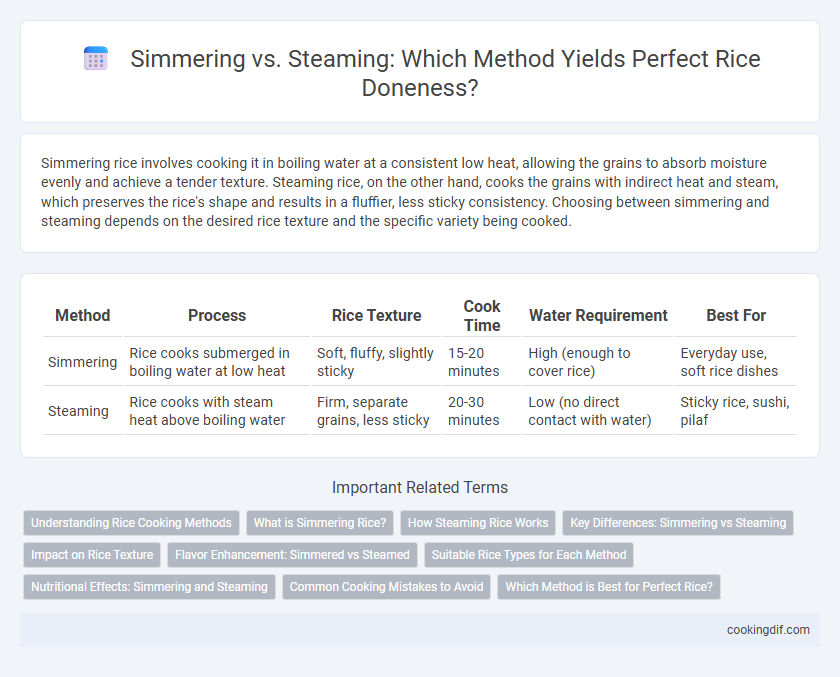Simmering rice involves cooking it in boiling water at a consistent low heat, allowing the grains to absorb moisture evenly and achieve a tender texture. Steaming rice, on the other hand, cooks the grains with indirect heat and steam, which preserves the rice's shape and results in a fluffier, less sticky consistency. Choosing between simmering and steaming depends on the desired rice texture and the specific variety being cooked.
Table of Comparison
| Method | Process | Rice Texture | Cook Time | Water Requirement | Best For |
|---|---|---|---|---|---|
| Simmering | Rice cooks submerged in boiling water at low heat | Soft, fluffy, slightly sticky | 15-20 minutes | High (enough to cover rice) | Everyday use, soft rice dishes |
| Steaming | Rice cooks with steam heat above boiling water | Firm, separate grains, less sticky | 20-30 minutes | Low (no direct contact with water) | Sticky rice, sushi, pilaf |
Understanding Rice Cooking Methods
Simmering rice involves cooking grains in a specific amount of boiling water until fully absorbed, resulting in tender, fluffy rice with separate grains. Steaming rice uses indirect heat and moisture, ideal for sticky or glutinous rice varieties, yielding a soft texture without waterlogged grains. Mastering the water-to-rice ratio and cooking time is essential for achieving perfect doneness with either method.
What is Simmering Rice?
Simmering rice involves cooking rice grains in water kept just below boiling point, typically around 185-205degF (85-96degC), allowing the rice to absorb moisture gradually while maintaining gentle heat. This method ensures even cooking and prevents the rice from burning or sticking to the pan, producing tender, fluffy grains. Simmering is ideal for dishes requiring fully cooked, non-sticky rice with separate grains, such as pilafs or plain white rice.
How Steaming Rice Works
Steaming rice involves cooking grains with indirect heat from boiling water, allowing even absorption of moisture without direct contact with water, which prevents overcooking and mushiness. This method uses a controlled steam environment to gently cook rice, preserving texture and enhancing flavor by maintaining individual grain integrity. Steaming ensures uniform doneness and ideal fluffiness, often preferred for delicate rice varieties like jasmine and basmati.
Key Differences: Simmering vs Steaming
Simmering rice involves cooking grains in boiling water at around 185-205degF, allowing them to absorb moisture directly, which results in a softer, stickier texture ideal for dishes like risotto or sushi. Steaming rice uses indirect heat with no direct water contact, preserving the grain's shape and producing a fluffy, separate texture commonly preferred for long-grain varieties such as basmati or jasmine. The key difference lies in moisture exposure and heat method, with simmering providing a more saturated cooking environment and steaming ensuring even, gentle cooking to maintain grain integrity.
Impact on Rice Texture
Simmering rice involves cooking it in boiling water just below the boiling point, which allows gradual absorption of water and results in a softer, stickier texture ideal for dishes like risotto or sushi. Steaming rice exposes it to moist heat without submersion in water, producing separate, fluffy grains with a firmer bite preferred in Asian cuisine like jasmine or basmati rice. The choice between simmering and steaming directly influences rice texture, moisture retention, and grain integrity, affecting the final culinary experience.
Flavor Enhancement: Simmered vs Steamed
Simmering rice allows the grains to absorb water gradually, enhancing the natural starch release and creating a richer, more cohesive flavor profile. Steaming preserves the individual grain texture by cooking with indirect heat, which maintains a cleaner, lighter taste and subtle aromatic qualities. The choice between simmering and steaming depends on whether a creamier texture or distinct grain separation is desired for optimal flavor.
Suitable Rice Types for Each Method
Simmering is ideal for long-grain rice varieties like Basmati and Jasmine, which benefit from gentle absorption of water to maintain fluffy, separate grains. Steaming suits sticky or short-grain rice types such as Sushi rice and Glutinous rice, preserving their moisture and promoting a tender, cohesive texture. Selecting the proper cooking method enhances the natural characteristics of each rice type, ensuring optimal doneness and flavor.
Nutritional Effects: Simmering and Steaming
Simmering rice involves cooking grains in boiling water, causing some nutrients, especially water-soluble vitamins like B-complex and minerals, to leach into the cooking water, which may be discarded. Steaming rice preserves more nutrients by cooking grains with indirect heat and minimal water exposure, retaining higher levels of vitamins, antioxidants, and minerals. Studies indicate steaming enhances nutrient retention, making it a preferred method for maintaining the rice's nutritional profile compared to simmering.
Common Cooking Mistakes to Avoid
Simmering rice at too high a temperature often leads to uneven cooking and mushy texture due to excessive water absorption. Steaming requires precise timing and moisture control to prevent undercooked grains or overly dry results. Avoid common mistakes such as lifting the lid frequently during steaming or boiling rice with insufficient water, which can disrupt the cooking process and affect doneness.
Which Method is Best for Perfect Rice?
Simmering provides precise temperature control, allowing rice to absorb water evenly for a tender, fluffy texture, making it ideal for most rice varieties. Steaming preserves nutrients and results in separate, fully cooked grains, often preferred for sticky or specialty rice types like jasmine or basmati. Choosing between simmering and steaming depends on the rice variety and desired texture, with simmering favored for versatility and steaming for maintaining grain integrity.
Simmering vs Steaming for rice doneness Infographic

 cookingdif.com
cookingdif.com